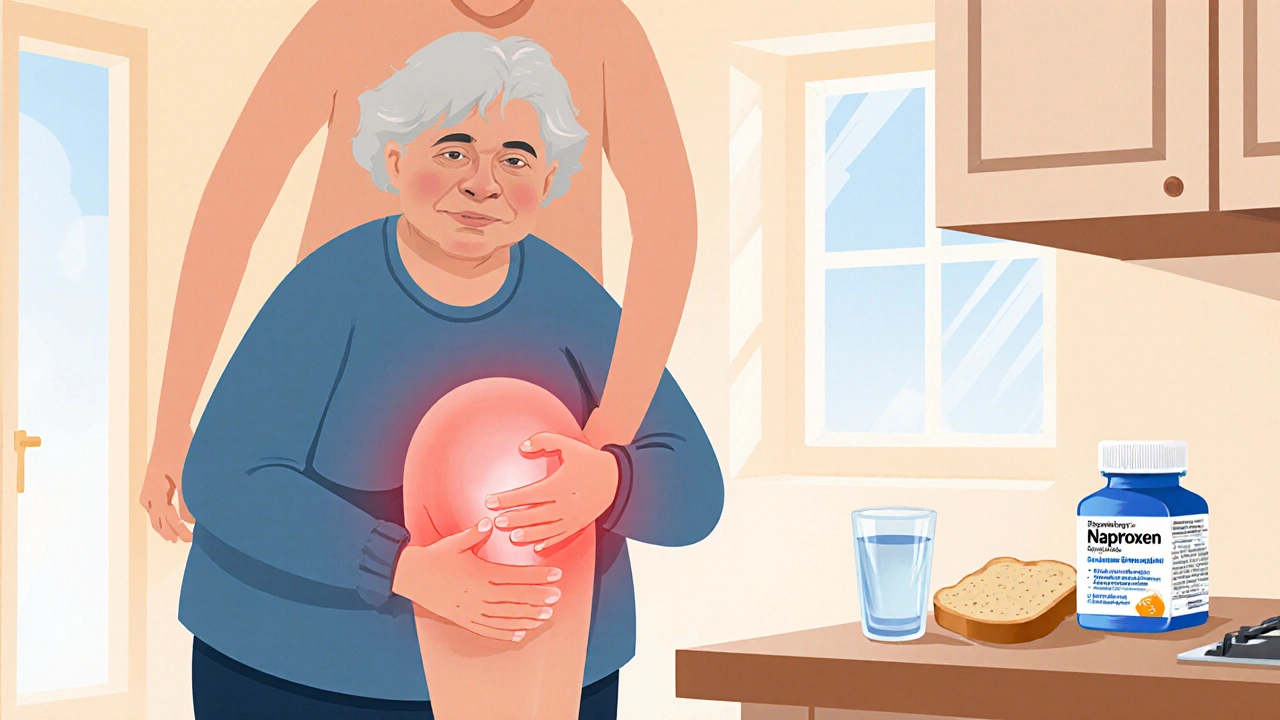
Naproxen Risk Assessment Tool
Personal Risk Assessment
This tool helps you understand your individual risk level when taking naproxen for osteoarthritis. Based on your health information, it will calculate your risk category and provide personalized safety recommendations.
Living with osteoarthritis means coping with joint stiffness, swelling, and nagging pain that can ruin everyday activities. One of the most common medicines doctors turn to is Naproxena non‑steroidal anti‑inflammatory drug (NSAID) that reduces inflammation and pain. But how exactly does it help, what should you watch out for, and is it the right choice for you? This guide walks through everything you need to know to use naproxen safely and effectively for osteoarthritis.
How Naproxen Works for Osteoarthritis Pain
Osteoarthritis is driven by the breakdown of cartilage and the resulting inflammation of the joint lining. Inflammation triggers the release of prostaglandins, chemicals that sensitize nerve endings and cause pain. Naproxen blocks the enzyme cyclooxygenase (COX), which is essential for prostaglandin production. By inhibiting COX‑1 and COX‑2, naproxen cuts down both the swelling and the pain signal, giving joints a chance to move more freely.
Typical Dosage and Administration
For most adults with osteoarthritis, the standard oral dose is 250mg to 500mg taken twice daily. The extended‑release formulation can be taken once daily at 500mg or 750mg. Always start with the lowest effective dose and take the tablet with food or a full glass of water to reduce stomach irritation. If you have kidney problems or are over 65, your doctor may recommend a lower dose or an alternative medication.
- Immediate‑release: 250mg every 12hours
- Extended‑release: 500mg once daily
- Maximum daily dose: 1500mg (rarely needed for osteoarthritis)
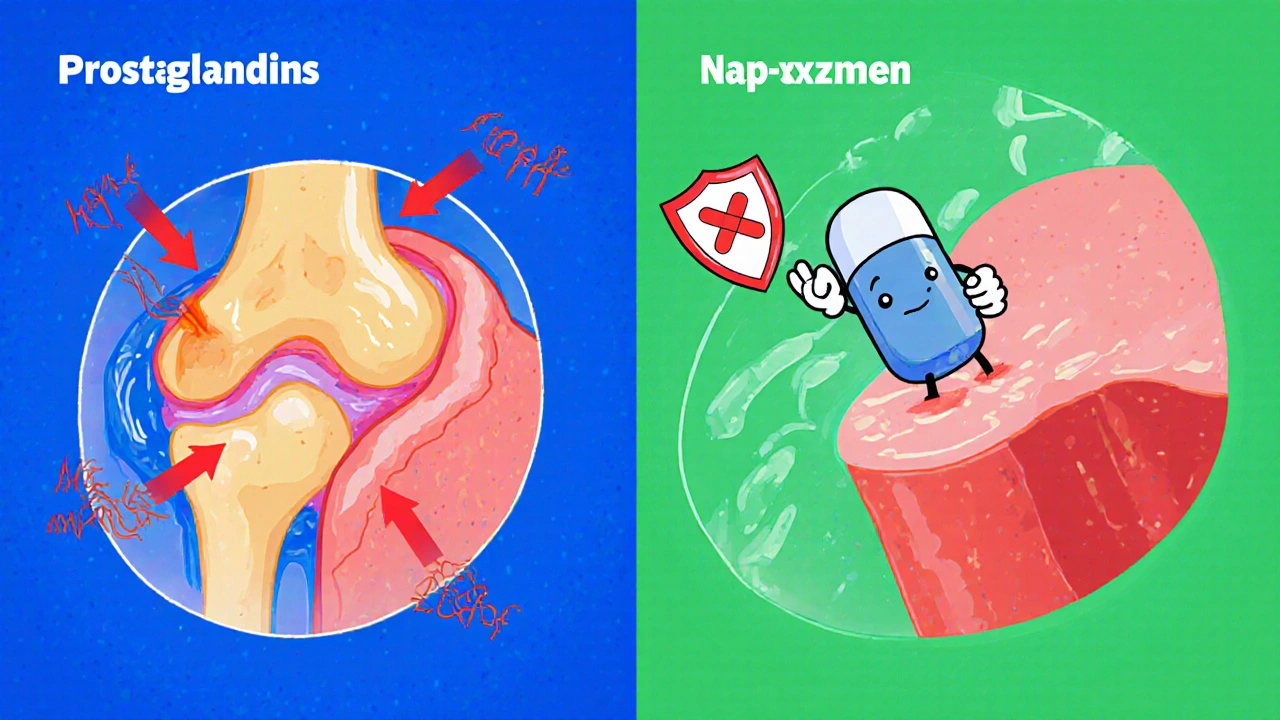
Benefits of Naproxen in Osteoarthritis
When used correctly, naproxen can provide lasting relief for many patients. Its relatively long half‑life (about 12‑14hours) means fewer daily doses compared with some other NSAIDs, which improves adherence. Studies show that naproxen reduces pain scores by 30‑40% in moderate to severe osteoarthritis, and its anti‑inflammatory action can also lessen joint swelling, giving you a smoother range of motion.
Risks and Side Effects
Like all NSAIDs, naproxen isn’t risk‑free. The most common complaints are gastrointestinal (GI) upset, such as heartburn, nausea, or mild stomach pain. More serious GI issues-ulcers or bleeding-can occur, especially in older adults or those taking steroids.
Other notable risks include:
- Gastrointestinal bleedingirritation of the stomach lining that can lead to ulcers or bleeding
- Cardiovascular riskpotential increase in heart attack or stroke risk, especially with long‑term high‑dose use
- Renal impairmentreduced kidney function that can worsen with prolonged NSAID use
If you have a history of heart disease, kidney disease, or stomach ulcers, talk to your doctor before starting naproxen. Protective strategies-like using the lowest effective dose, taking a proton‑pump inhibitor (PPI), or alternating with other pain relievers-can help mitigate these risks.
Comparing Naproxen with Other NSAIDs
Choosing the right NSAID often depends on how quickly the drug works, how long it lasts, and its safety profile. Below is a quick side‑by‑side look at three common options for osteoarthritis.
| Drug | Onset of Action | Duration | COX Selectivity | GI Risk | Cardio Risk | OTC Availability |
|---|---|---|---|---|---|---|
| Naproxen | 30-60 min | 12-14 hrs | Non‑selective (COX‑1 & COX‑2) | Moderate | Low to moderate | Both OTC (225mg) and prescription |
| Ibuprofen | 15-30 min | 4-6 hrs | Non‑selective | Low‑moderate | Low | OTC (200mg‑800mg) |
| Celecoxib | 45-60 min | 12-24 hrs | COX‑2 selective | Low | Higher (especially in patients with heart disease) | Prescription only |
In short, naproxen offers a longer window of relief than ibuprofen and a lower cardiovascular threat than celecoxib, making it a solid middle‑ground choice for many osteoarthritis patients.
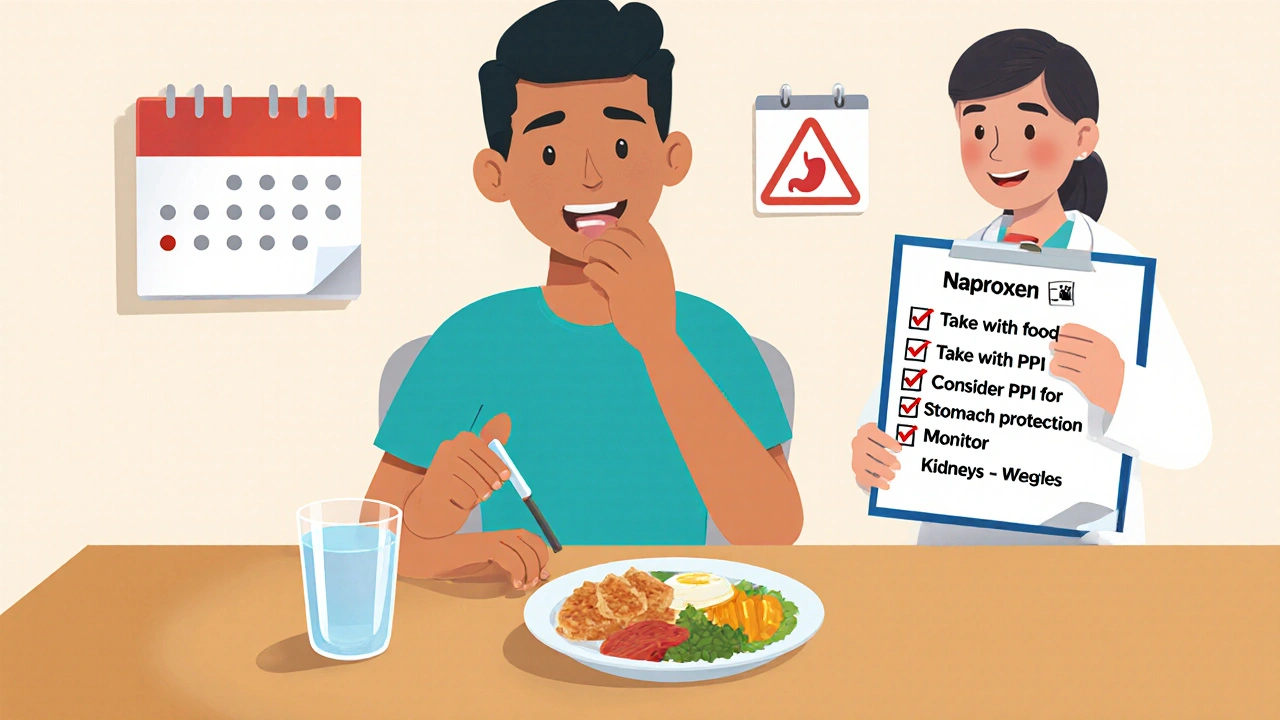
Practical Tips for Safe Use
- Take naproxen with food, milk, or a full glass of water to protect your stomach.
- If you need long‑term therapy, discuss adding a proton‑pump inhibitor (e.g., omeprazole) with your doctor.
- Never combine naproxen with other NSAIDs (including aspirin) unless directed by a healthcare professional.
- Check your other medications for potential interactions-naproxen can raise blood levels of certain blood thinners, antihypertensives, and lithium.
- Monitor for warning signs: dark stools, sudden stomach pain, new swelling in the legs, or unexplained shortness of breath. Seek medical help right away if any appear.
When to See a Healthcare Provider
If you notice any of the following, schedule an appointment:
- Pain that doesn’t improve after 2 weeks of consistent naproxen use.
- Persistent gastrointestinal discomfort despite taking it with food.
- History of heart disease, stroke, or uncontrolled high blood pressure.
- Kidney problems or a recent decline in urine output.
- Need for stronger pain control-your doctor may suggest a different class of medication or a joint injection.
Regular check‑ups allow your clinician to monitor blood pressure, kidney function, and any signs of GI bleeding, ensuring the benefits continue to outweigh the risks.
Frequently Asked Questions
Can I take naproxen with my blood pressure medication?
Naproxen can reduce the effectiveness of some blood pressure drugs, especially ACE inhibitors and diuretics. Talk to your doctor; they may adjust the dose or suggest a different pain reliever.
Is naproxen safe for people over 65?
Older adults have a higher risk of GI bleeding and kidney issues. If you’re 65 or older, start at the lowest dose, take it with food, and consider a protective PPI. Regular monitoring is essential.
How does naproxen differ from ibuprofen?
Both are non‑selective NSAIDs, but naproxen lasts longer (12‑14hours vs. 4‑6hours for ibuprofen) and often requires fewer daily doses. Naproxen’s GI risk is slightly higher, while ibuprofen may be gentler on the stomach for short courses.
Can I use naproxen for both osteoarthritis and occasional migraines?
Yes, naproxen can treat both conditions, but dosing schedules differ. For migraines you might take a single 500mg dose at the onset of pain, while osteoarthritis management requires regular dosing. Always follow your doctor’s guidance.
What should I do if I miss a dose?
Take the missed dose as soon as you remember, unless it’s almost time for the next scheduled dose. In that case, skip the missed one and continue with your regular schedule-don’t double‑dose.
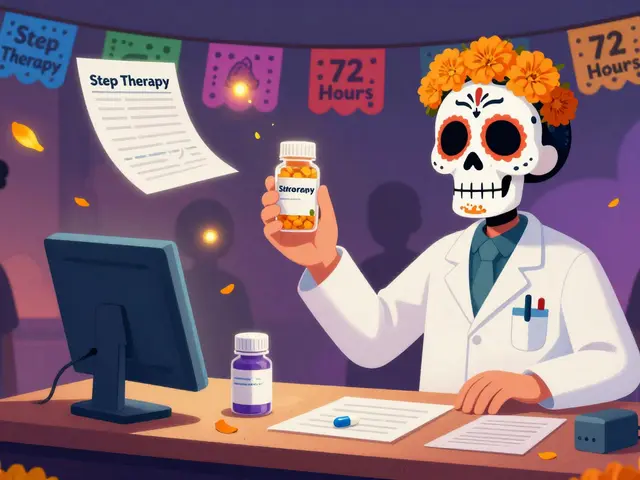

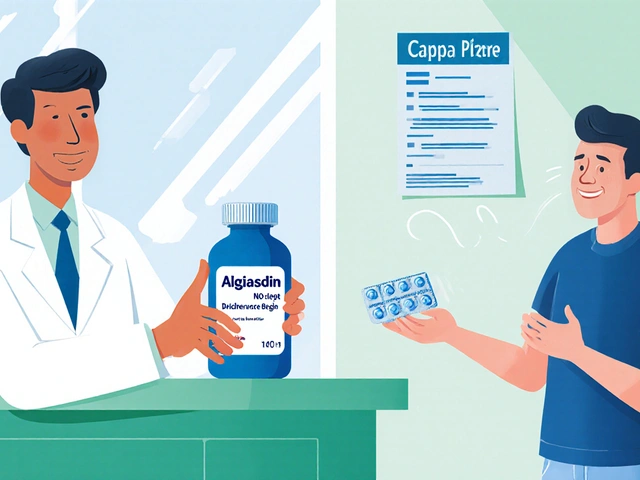


There are 16 Comments
Michael Taylor
If you’re battling osteoarthritis, naproxen can be a trusty sidekick in the quest for pain relief!
It works by putting the brakes on the COX enzymes, which means fewer prostaglandins screaming at your joints!
Because it sticks around for about twelve to fourteen hours, you often only need to pop a pill twice a day, which is a boon for busy lives!
Starting at the lowest effective dose, such as 250 mg, gives you a chance to test the waters without overloading your stomach!
Taking it with food or a full glass of water forms a protective shield for the gastric lining, reducing that dreaded heartburn!
For those over sixty‑five, the body’s ability to clear the drug slows, so the doctor may suggest a smaller dose or a different NSAID!
If you have a history of ulcers, pairing naproxen with a proton‑pump inhibitor can act like a bodyguard for your gut!
Keep an eye on your blood pressure, because naproxen can sometimes nudge it upward, especially when mixed with certain antihypertensives!
Kidney function is another checkpoint; if labs show a dip, it may be time to reconsider the regimen!
The risk‑assessment tool in the article helps you tally points for age, kidney health, heart history, stomach issues, and other meds!
A score of five or more nudges you into the high‑risk zone, where a conversation with your physician becomes essential!
Moderate scores signal a need for caution, perhaps adding a low‑dose PPI and scheduling periodic lab checks!
Low scores usually mean you can enjoy naproxen’s benefits while following standard dosing guidelines!
Remember, naproxen is not a cure‑all; physical therapy, weight management, and joint‑friendly exercise round out a comprehensive plan!
Staying active, even with gentle swimming or cycling, can amplify the pain‑relieving effects of the medication!
So, arm yourself with knowledge, talk to your healthcare team, and let naproxen be one piece of the puzzle toward smoother, happier moves!
Troy Brandt
One of the biggest advantages of naproxen is its relatively long half‑life, which often translates into just two doses a day for most patients; this can improve adherence compared to shorter‑acting NSAIDs.
When you’re starting therapy, it’s wise to begin at 250 mg twice daily and only increase if pain control is still inadequate, always keeping an eye on gastrointestinal tolerance.
If you have concomitant cardiovascular risk factors, opting for the lowest effective dose and pairing it with a proton‑pump inhibitor can mitigate the modest increase in heart‑related events that some studies have noted.
Renal monitoring is essential, especially in older adults or those on diuretics; a simple serum creatinine check after a few weeks can catch early signs of reduced kidney function.
Patients with a prior ulcer history should definitely discuss prophylactic strategies-sometimes a low‑dose PPI or switching to a COX‑2‑selective agent is the safer route.
It’s also worth noting that naproxen can interact with certain antihypertensives, potentially blunting their effect; dose adjustments may be necessary under physician guidance.
Overall, the drug provides a solid balance of efficacy and convenience, but it shines brightest when paired with lifestyle measures like weight management and low‑impact exercise.
Never hesitate to bring up any new or worsening symptoms with your provider, as timely intervention can keep you on the path to smoother joint function.
Barbra Wittman
Oh, sure, because everyone loves the thrill of trying to remember whether they took a naproxen tablet with breakfast or with lunch-what a delightful guessing game!
And let’s not forget the charming possibility of an unexpected stomach ulcer that appears out of nowhere, just to keep life interesting.
If you’re over 65, congratulations, you now get the exclusive privilege of extra monitoring and possibly a lower dose-because why make things simple?
Of course, the drug’s ability to linger for half a day is a neat trick, unless you’re also on a blood thinner, in which case you might as well audition for a medical drama.
Don’t worry about kidney function; a quick blood test will tell you if your kidneys are on strike, and then you can either stop the medication or hope for the best.
And the risk‑assessment tool? It’s basically a point‑scoring game that tells you whether you’re in the “high‑risk” or “moderate‑risk” club-membership is optional, but the price is your health.
In short, naproxen is a wonderful compromise between pain relief and a gentle reminder that nothing in medicine is free.
Gena Thornton
Naproxen’s extended‑release formulation can be a real convenience for people who struggle to remember a twice‑daily schedule; you just take one tablet in the morning and you’re covered through the evening.
Make sure you swallow the tablet whole-crushing it defeats the time‑release mechanism and spikes the dose, which could irritate your stomach.
If you’re already on a blood pressure medication, let your doctor know; naproxen can lessen the effectiveness of some ACE inhibitors and diuretics.
For those with a prior ulcer, a concurrent proton‑pump inhibitor is often recommended to protect the gastric lining.
Regular lab work, especially checking kidney function and blood pressure, helps spot any issues early while you stay on therapy.
Lynnett Winget
Picture this: a gentle sunrise over a calm lake, and you strolling with fluid, pain‑free joints thanks to a well‑timed naproxen dose-pure poetry in motion!
When you pair the medication with a dash of colorful anti‑inflammatory foods like turmeric and ginger, you’re basically painting a masterpiece of joint health.
Even if you’re battling the occasional stomach upset, a hearty breakfast or a glass of milk can act like a soft blanket for your gut.
Remember, the key is balance; too much can tip the scales toward risk, but just enough can let you dance through the day without that nagging ache.
So, keep the rhythm, stay mindful of your body’s signals, and let naproxen be the gentle cadence in your wellness symphony.
Amy Hamilton
Naproxen offers a pragmatic approach to osteoarthritis pain, delivering consistent relief with twice‑daily dosing.
Adhering to the lowest effective dose minimizes gastrointestinal and cardiovascular risks while preserving efficacy.
Patients with renal insufficiency should undergo periodic assessment of serum creatinine and adjust dosage accordingly.
Co‑administration of a proton‑pump inhibitor is advisable for those with prior ulcer disease.
Engaging in low‑impact exercise complements pharmacologic therapy and may reduce overall medication dependence.
Lewis Lambert
Imagine the stage lights dimming as you step onto the floor-your joints, once shackled by pain, now glide with a grace that feels almost cinematic!
That’s the drama naproxen can deliver when used responsibly-steady, long‑lasting relief that lets you reclaim daily activities.
But every star needs a crew; your physician, a PPI, and perhaps a physical therapist collaborate to keep the spotlight focused on health.
Watch for warning signs like dark stools or sudden swelling; those are cues to call for an intermission and seek medical advice.
With the right script, you’ll exit the scene of discomfort and take a bow for a pain‑free encore.
Tamara de Vries
hey guys, just a quick heads up – if ur takin naproxen and u got any stomach probs, try eatin sum bread or milks before – it really helps!!
i once forgot to take it with food and i had a gnarly heartburn that night – not fun!!
also, dont forget to check in with ur doc if u notice weird stuff like dark pee or swelling – better safe than sorry!!
Jordan Schwartz
I’ve found that keeping a simple log of when I take naproxen, what I eat, and any side effects really helps me and my doctor fine‑tune the regimen.
When you notice a pattern, like occasional stomach upset after a higher dose, you can discuss lowering the dose or adding a protective agent.
Staying proactive and communicating openly ensures you get the pain relief you need without compromising safety.
Nitin Chauhan
Take naproxen with food; stay hydrated. Monitor blood pressure. Check kidneys regularly.
Dannii Willis
From a balanced perspective, naproxen provides solid analgesia for many osteoarthritis sufferers, yet it isn’t without its caveats.
Adhering to dosing guidelines and pairing the drug with protective measures, such as a proton‑pump inhibitor when indicated, can mitigate gastrointestinal risks.
Regular follow‑up appointments allow clinicians to monitor blood pressure and renal function, ensuring safety over the long term.
Overall, the medication’s benefits often outweigh the potential drawbacks when used judiciously.
Robyn Du Plooy
In clinical practice, naproxen’s pharmacokinetic profile-specifically its 12‑hour half‑life-optimizes patient adherence while maintaining COX‑1/COX‑2 inhibition across the dosing interval.
For individuals with comorbidities, integrating naproxen within a multidisciplinary pain management protocol, leveraging physiotherapy and nutraceuticals, enhances therapeutic outcomes.
However, vigilance for NSAID‑induced nephrotoxicity and GI bleeding remains paramount, especially in polypharmacy scenarios where drug‑drug interactions can amplify adverse event risk.
Boyd Mardis
Naproxen: effective, convenient, but not without caution.
Zach Yeager
Stay away from cheap meds.
Desiree Tan
Listen to your body – if naproxen starts making you feel off, speak up immediately; ignoring symptoms only makes things worse!
Don’t let anyone convince you that you must stay on the same dose forever; dose adjustments are normal and show responsible care.
Take control, track your reactions, and demand the best possible management for your joints.
Andrea Dunn
Seriously, did you know big pharma hides the real side‑effects of naproxen? 🤔
There’s a whole network of “research” that downplays GI bleeding – it’s all a cover‑up!
Stay informed, question the studies, and consider natural alternatives if you can.
Don’t let the system keep you in the dark.
Write a comment
Your email address will not be published. Required fields are marked *